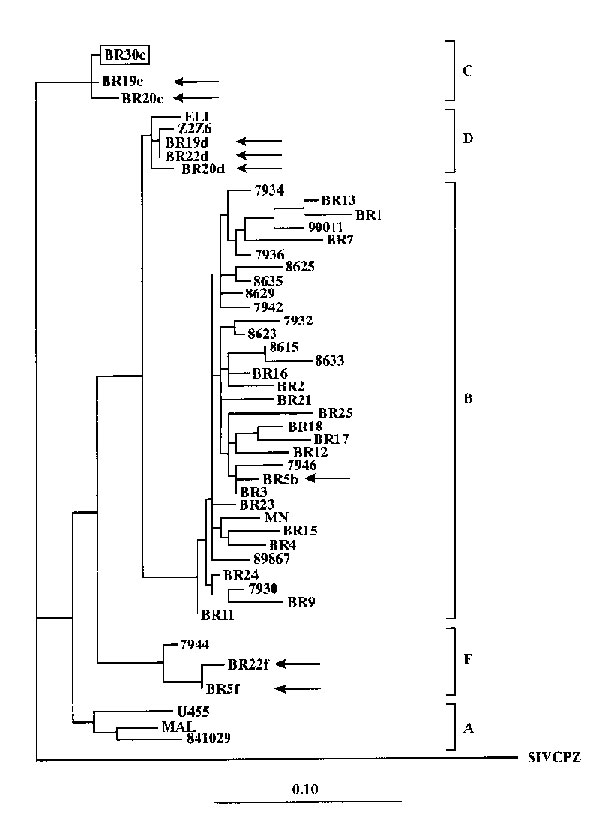Volume 1, Number 3—July 1995
Dispatch
HIV-1 Patients May Harbor Viruses of Different Phylogenetic Subtypes: Implications for the Evolution of the HIV/AIDS Pandemic
Figure 2

Figure 2. Phylogenetic classification of HIV-1 strains in dually infected patients. HIV-1 sequences from dual infections (Br5, 19, 20, and 22) are indicated by arrows, and the major strain in the infected child (Br30) is boxed. The tree was constructed on the basis of the DNA sequences of the protease gene by using the maximum likelihood method with the fast DNAml program (6). SIV-cpz protease sequence was used as an outgroup. The distinct HIV-1 subtypes are delineated. The scale bar shows the ratio of nucleotide substitutions for given horizontal branch length. Vertical distances are for clarity only.
References
- Rayfield M, De Cock K, Heyward W, Mixed human immunodeficiency virus (HIV) infection in an individual: demonstration of both type 1 and type 2 proviral sequences by using polymerase chain reaction. J Infect Dis. 1988;158:1170–6.PubMedGoogle Scholar
- Pieniazek D, Peralta JM, Ferreira JA, Identification of mixed HIV-1/HIV-2 infections in Brazil by polymerase chain reaction. AIDS. 1991;5:1293–9. DOIPubMedGoogle Scholar
- Grez M, Dietrich U, Balfe P, Genetic analysis of human immunodeficiency virus type 1 and 2 (HIV-1 and HIV-2) mixed infections in India reveals a recent spread of HIV-1 and HIV-2 from a single ancestor for each of these viruses. J Virol. 1994;68:2161–8.PubMedGoogle Scholar
- Artenstein AW, VanCott TC, Mascola JR, Dual infection with HIV type 1 of distinct envelope subtypes in humans. J Infect Dis. 1995;171:805–10.PubMedGoogle Scholar
- Gao F, Yue L, Robertson DL, Genetic diversity of human immunodeficiency virus type 2: evidence for distinct sequence subtypes with differences in virus biology. J Virol. 1994;68:7433–47.PubMedGoogle Scholar
- Larsen N, Olsen GJ, Maidak BN. el al. The ribosomal database project. Nucleic Acids Res. 1993;21:3021–3. DOIPubMedGoogle Scholar
Page created: December 20, 2010
Page updated: December 20, 2010
Page reviewed: December 20, 2010
The conclusions, findings, and opinions expressed by authors contributing to this journal do not necessarily reflect the official position of the U.S. Department of Health and Human Services, the Public Health Service, the Centers for Disease Control and Prevention, or the authors' affiliated institutions. Use of trade names is for identification only and does not imply endorsement by any of the groups named above.